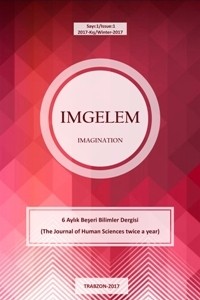ERKEN MODERN SANATTA RAYONİZM – KISACIK BİR IŞIK IŞINI
Bu çalışmada, Rayonizm (Rayism veya Luchizm) olarak bilinen 20. yüzyılın ilk yarısının geçici Rus avangart sanatsal hareketi araştırılmaktadır. İdeolojik çağrışımların farkında kalırken nesnel olarak gözlemlenebilir unsurlara dayanan bir miktar netliğe izin veren çağdaş hareketler ve öncülleriyle (Cubo-Fütürizm, Orfizm, Kübizm, Fütürizm) karşılaştırmalı biçimci ve kavramsal analizler ana araştırma yöntemleri olarak seçilmiştir. Çalışma, hareketin tanıtılmasıyla başlamakta ve ardından Rayonizmin sanat ve fikir olarak belirgin benzerliklerini ve farklı benzersiz özelliklerini vurgulayan tarihsel ve ideolojik bağlamın ilgili unsurları ile aşılanmış karşılaştırmalı analizlerle devam etmekte ve hareketin (kaçınılmaz olarak) düşüşünün olası nedenlerinin (ana sanatçıların travması, kışkırtıcı üstünlüğün olmaması) ve kavramsal zayıflıklarının (gerçek yeniliklerin olmaması) tartışılmasıyla sona ermektedir. Çalışma, sanatsal dünya evriminin daha geniş bağlamındaki rolüne sanatçının bilim insanı olarak rolünün yeniden kavramsallaştırılmasına ve nesnel temsilden saf soyutlamaya doğru bir geçiş sağlaması bakımından önem taşımaktadır.
Anahtar Kelimeler:
Rus Avangardı, Rayonizm, Orfizm, Fütürizm, Kübizm
RAYONISM IN EARLY MODERN ART – A FLEETING RAY OF LIGHT
Current research paper explores the fleeting Russian avant-garde artistic movement of the first half of the 20th century known as Rayonism (Rayism or Luchizm). Comparative formalist and conceptual analyses with its contemporary movements and predecessors (Cubo-Futurism, Orphism, Cubism, Futurism) are chosen as the main methods of research as permitting some clarity based on the objectively observable elements while remaining aware of ideological connotations. The article opens up with the introduction of the movement and then proceeds with comparative analyses infused with relevant elements of historical and ideological context highlighting evident similarities and distinct unique features of Rayonism as art and idea. The article is concluded with discussion of possible reasons for the (inevitable) decline of the movement (trauma of the main artists, lack of provocative edge) as well as its conceptual weaknesses (lack of genuine innovation). Its role in the greater context of the artistic world evolution is attributed to the reconceptualization of the role of artist as scientist and providing a shift from objective representation towards pure abstraction.
Keywords:
Russian Avant-garde, Rayonism, Orphism, Futurism, Cubism,
___
- Barok, D. (2020, 23 September). Lariónov Mikhail Fiódorovich. - Monoskop. https://monoskop.org/Mikhail_Larionov
- Bowlt, J. E. (1988). Russian Art of the Avant-Garde: Theory and Criticism. New York: Thames and Hudson.
- Chipp, H. B. (1958). Orphism and Color Theory, The Art Bulletin, 40(1), 55-63.
- Dietrich, A. (2018, 17 August). Russian culture - 20th century. - Humanities Institute. http://humanitiesinstitute.org/assets/russia46246.culture.20.pdf
- Douglas, C. (1975). The New Russian Art and Italian Futurism, Art Journal, 34(3), 229-239.
- Gowing, L. (2019, November 01). Cubism and its consequences. - Encyclopaedia Britannica. https://www.britannica.com/art/Western-painting/Cubism-and-its-consequences
- Kowtun, J. (1998). Michail Larionow. 1881-1964. Bournemouth: Parkstone Press.
- Larionov, M. (1913). Rayonist Painting. Moscow: The Donkey's Tail and Target.
- Larionov, M., Goncharova, N. (1913). Rayonists and Futurists: A Manifesto. Moscow: Oslinyj Khvost i Mishen.
- Parton, A. (2003). Cubo-Futurism. - Grove Art Online. doi:https://doi.org/10.1093/gao/9781884446054.article.T020562
- Seiferle, R. (2021). Orphism Movement Overview and Analysis. - TheArtStory.org. https://www.theartstory.org/movement/orphism/history-and-concepts/
- Yayın Aralığı: Yılda 2 Sayı
- Başlangıç: 2017
- Yayıncı: Musa Yavuz ALPTEKİN
Sayıdaki Diğer Makaleler
DÜZENSİZ GÖÇMENLERDE SOSYO-KÜLTÜREL ENTEGRASYON: ANKARA’DA YAŞAYAN AFGAN-ÖZBEK TÜRKLER
PARASAL DÜZENLEME ARACI OLARAK ENFLASYON
MADDE KULLANIMI VE BABA OĞUL İLİŞKİLERİNE DAİR NİTEL BİR DEĞERLENDİRME
İlker AKTÜRK, Ömer Miraç YAMAN
TÜRKİYE-BULGARİSTAN GÜZERGÂHININ KARANLIK TARAFI
DICKENS’IN ANDROJENLİK KAVRAMI: DAVID COPPERFIELD’DA TOPLUMSAL CİNSİYET İLİŞKİLERİ
1965-2000 ARASI TÜRK MİZAH BASININDA SÜLEYMAN DEMİREL TEMSİLLERİ
Zeynep BAKİ, Ahmed Ünal BOZYER
SOUND OF METAL FİLMİ ÖRNEĞİNDE BEDENE VEDA VE SESSİZLİĞİN SESİ
